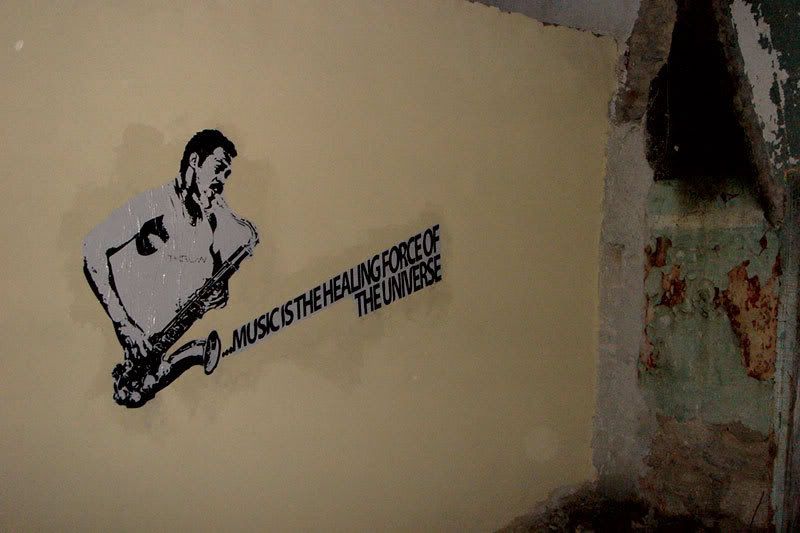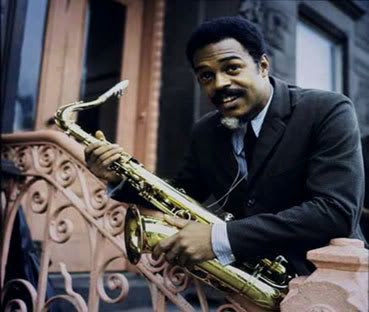
14 December 2007
01 December 2007
Albert Ayler (1936 - 1970)


Albert Ayler was born in Cleveland, Ohio on July 13th, 1936. His father, Edward, encouraged an early interest in music and taught Albert to play the alto sax. His musical training continued at the local academy of music and John Adams High School, where he also played the oboe. In 1951, at the age of 15, Albert joined his first group, Lloyd Pearson and his Counts of Rhythm, which led to a job with Little Walter Jacobs. He spent the following two summer vacations on the road with the R&B band. In 1954, Albert graduated high school and went to a local college but in 1956, due to lack of money, he left college and joined the army. His musical education continued, playing in the military band for seven hours a day, then practicing with his fellow musicians. In 1959 he was transferred to France for two years. In 1961 he left the army and after a short time in California, returned to Cleveland.
By now Albert was developing his own ‘free jazz’ style, so inevitably there was no work. In early 1962, he returned to Europe, settling in Sweden. He made his first recordings at a private session and these were not widely released until a few years later. Later in ‘62 he met up with Don Cherry (who was touring with Sonny Rollins), and with whom he would later record four albums. Then in December he saw the Cecil Taylor group in Stockholm and asked if he could join them. He travelled with Taylor to Denmark and made his official debut album, “My Name Is Albert Ayler” in January 1963, with a pick-up group of local musicians.
He returned to America, settled in New York and continued to play with Cecil Taylor until the work (and the money) ran out. He then returned to Cleveland for a while (a regular pattern in his life, money was always a problem and he received economic support from his parents, and later from John Coltrane) before moving back to New York. He played at a few jam sessions at Ornette Coleman's house around December 1963. On January 14th, 1964, Albert married Arlene Benton.
In February 1964 there was a recording session organised in New York by the Danish label, Debut Records. This resulted in the "Witches and Devils" LP (aka "Spirits"), and the set of spirituals and other traditional material which was released posthumously. Albert then formed a trio with Gary Peacock on bass and Sunny Murray on drums. As well as a live LP (again released posthumously), this is the unit which produced the universally acknowledged classic jazz album, "Spiritual Unity", which was recorded in July 1964 and released on the new ESP label. Albert`s second LP for ESP was the soundtrack album, "New York Eye And Ear Control", which featured a larger group, including Don Cherry. The Cafe Montmartre in Copenhagen then invited Albert to return to Europe. Don Cherry was added to the regular trio and the group made the outstanding record, "Ghosts" (aka "Vibrations", "Mothers and Children") in September 1964. Don Cherry had decided to remain in Europe, so when Albert returned to New York, he asked his brother, Donald, to join his band.
With the addition of Donald Ayler, Albert`s music changed yet again, at times sounding like a New Orleans marching band, which gave the regular jazz critics even more problems, wondering whether it was meant to be taken seriously or as a parody. When ESP issued "Bells", recorded in 1965 and released as a one-sided, see-through disc, the name of Albert Ayler became even more notorious. Although the "Free Jazz" movement was at its height in the mid-Sixties (Albert even made the cover of Downbeat), it was never a popular form of music. Albert Ayler was working, but he still relied on his parents and John Coltrane for financial support. He'd also left his wife around the beginning of 1966, after he met Mary Parks.
There was another European tour in November 1966. On November 15th he played at the London School of Economics. This concert was recorded for the BBC2 "Jazz Goes To College" series, but it was never broadcast and the tape was later destroyed.
On his return from Europe, Albert embarked on his first major recording contract, since John Coltrane had finally persuaded Bob Thiele at Impulse Records to sign him to the label. It is difficult to overestimate the influence of Coltrane on Ayler, not musically, but in terms of support and encouragement. Coltrane was constantly "cleaning the mirror", his music becoming more and more uncompromising. Perhaps it`s wrong to speculate, but one can't help but wonder whether Albert's music would have changed so radically during the Impulse years if he'd had his friend there to guide him. John Coltrane died on July 17th 1967.
After the magnificence of "In Greenwich Village" and "Love Cry", came the selling-out of "New Grass" and the banality of "Music Is The Healing Force Of The Universe". Whether this was a genuine attempt to make his music more accessible and spread his spiritual message further, or whether he just did it for the money, either way it didn't work. The contract with Impulse was terminated. The problems with the music were reflected in Albert's private life. In the summer of 1968 he stopped working with his brother. According to Donald this was because of the influence of Mary Parks, but he also had his own problems and ended up having a nervous breakdown and was institutionalised for a time. In July 1970, Albert played his last concerts in France.
On November 25, 1970, Albert Ayler's body was found floating in the East River, at the foot of Congress Street Pier, in Brooklyn.
* Albert Ayler : "His Life and Music" by Jeff Schwartz
By now Albert was developing his own ‘free jazz’ style, so inevitably there was no work. In early 1962, he returned to Europe, settling in Sweden. He made his first recordings at a private session and these were not widely released until a few years later. Later in ‘62 he met up with Don Cherry (who was touring with Sonny Rollins), and with whom he would later record four albums. Then in December he saw the Cecil Taylor group in Stockholm and asked if he could join them. He travelled with Taylor to Denmark and made his official debut album, “My Name Is Albert Ayler” in January 1963, with a pick-up group of local musicians.
He returned to America, settled in New York and continued to play with Cecil Taylor until the work (and the money) ran out. He then returned to Cleveland for a while (a regular pattern in his life, money was always a problem and he received economic support from his parents, and later from John Coltrane) before moving back to New York. He played at a few jam sessions at Ornette Coleman's house around December 1963. On January 14th, 1964, Albert married Arlene Benton.
In February 1964 there was a recording session organised in New York by the Danish label, Debut Records. This resulted in the "Witches and Devils" LP (aka "Spirits"), and the set of spirituals and other traditional material which was released posthumously. Albert then formed a trio with Gary Peacock on bass and Sunny Murray on drums. As well as a live LP (again released posthumously), this is the unit which produced the universally acknowledged classic jazz album, "Spiritual Unity", which was recorded in July 1964 and released on the new ESP label. Albert`s second LP for ESP was the soundtrack album, "New York Eye And Ear Control", which featured a larger group, including Don Cherry. The Cafe Montmartre in Copenhagen then invited Albert to return to Europe. Don Cherry was added to the regular trio and the group made the outstanding record, "Ghosts" (aka "Vibrations", "Mothers and Children") in September 1964. Don Cherry had decided to remain in Europe, so when Albert returned to New York, he asked his brother, Donald, to join his band.
With the addition of Donald Ayler, Albert`s music changed yet again, at times sounding like a New Orleans marching band, which gave the regular jazz critics even more problems, wondering whether it was meant to be taken seriously or as a parody. When ESP issued "Bells", recorded in 1965 and released as a one-sided, see-through disc, the name of Albert Ayler became even more notorious. Although the "Free Jazz" movement was at its height in the mid-Sixties (Albert even made the cover of Downbeat), it was never a popular form of music. Albert Ayler was working, but he still relied on his parents and John Coltrane for financial support. He'd also left his wife around the beginning of 1966, after he met Mary Parks.
There was another European tour in November 1966. On November 15th he played at the London School of Economics. This concert was recorded for the BBC2 "Jazz Goes To College" series, but it was never broadcast and the tape was later destroyed.
On his return from Europe, Albert embarked on his first major recording contract, since John Coltrane had finally persuaded Bob Thiele at Impulse Records to sign him to the label. It is difficult to overestimate the influence of Coltrane on Ayler, not musically, but in terms of support and encouragement. Coltrane was constantly "cleaning the mirror", his music becoming more and more uncompromising. Perhaps it`s wrong to speculate, but one can't help but wonder whether Albert's music would have changed so radically during the Impulse years if he'd had his friend there to guide him. John Coltrane died on July 17th 1967.
After the magnificence of "In Greenwich Village" and "Love Cry", came the selling-out of "New Grass" and the banality of "Music Is The Healing Force Of The Universe". Whether this was a genuine attempt to make his music more accessible and spread his spiritual message further, or whether he just did it for the money, either way it didn't work. The contract with Impulse was terminated. The problems with the music were reflected in Albert's private life. In the summer of 1968 he stopped working with his brother. According to Donald this was because of the influence of Mary Parks, but he also had his own problems and ended up having a nervous breakdown and was institutionalised for a time. In July 1970, Albert played his last concerts in France.
On November 25, 1970, Albert Ayler's body was found floating in the East River, at the foot of Congress Street Pier, in Brooklyn.
* Albert Ayler : "His Life and Music" by Jeff Schwartz
Subscribe to:
Comments (Atom)

